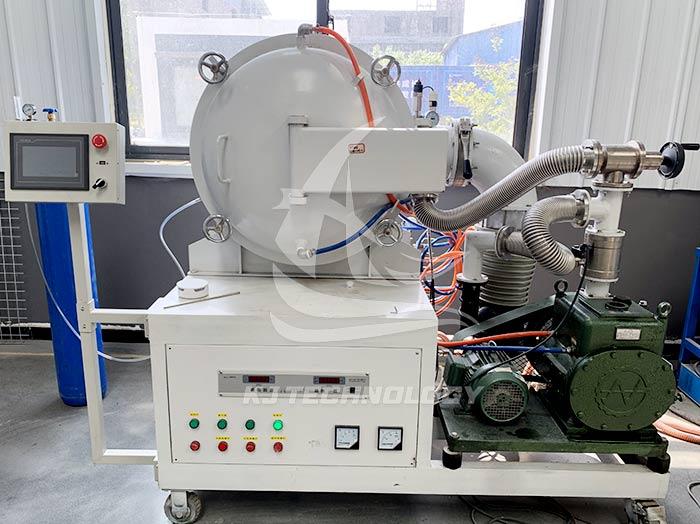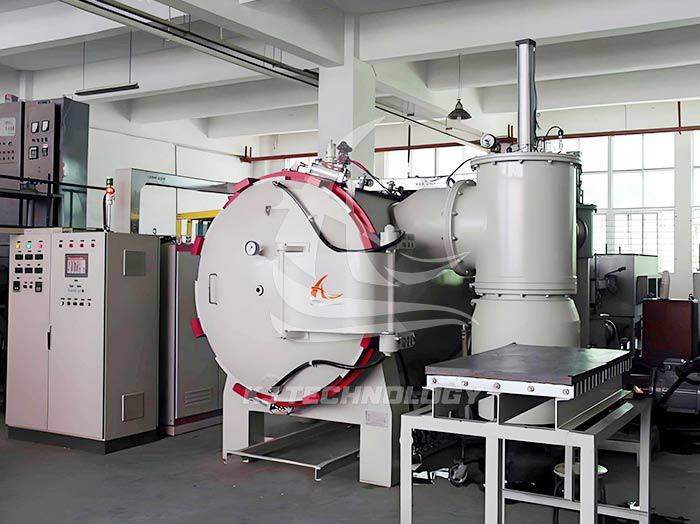Can a vertical graphite vacuum furnace be used for graphitization?
 09-03-2025 Author: KJ technology
09-03-2025 Author: KJ technology
Vertical graphite vacuum furnace can be used for graphitization treatment and has significant technical advantages and wide applications in the new materials industry. The following is a specific analysis:
1. Technical feasibility: High temperature vacuum environment meets the core requirements of graphitization
Graphitization treatment needs to be carried out at high temperatures of 2000-3000 ℃, by transforming the carbon material structure from disordered to highly ordered graphite crystals, improving the material's conductivity, thermal conductivity, and mechanical strength. The vertical graphite vacuum furnace achieves this goal through the following design:
High temperature capability:
Using resistance heating (graphite heating element), the maximum temperature can reach 3000 ℃, meeting the temperature requirements for graphitization treatment.
Vacuum environment control:
The vacuum degree can be maintained at 10 ⁻³~10 ⁻² Pa, effectively inhibiting oxidation reactions (avoiding the formation of CO/CO ₂ between carbon and oxygen), while extracting gases, ash, and low boiling impurities from the material, improving material purity. For example, in a semiconductor monocrystalline silicon growth furnace, the metal impurity content of the graphite crucible needs to be less than 10 ppm, and the vacuum environment of a vertical vacuum furnace can meet this strict requirement.
Atmosphere control:
At specific process stages, argon (Ar) or nitrogen (N ₂) can be introduced to adjust the furnace pressure to suppress material volatilization (such as lithium loss in the negative electrode of lithium-ion batteries) and improve temperature uniformity.
2. Application scenarios: covering key areas of the new materials industry
Vertical graphite vacuum furnaces are widely used in the new materials industry, covering the following core scenarios:
Preparation of carbon carbon composite materials:
Used for graphitization treatment of components such as aircraft turbines, brake discs, and leading edges of space shuttle wings, to enhance material high-temperature resistance (up to 3000 ℃) and lightweight characteristics.
Synthesis of graphene and carbon nanotubes:
By precisely controlling the heating temperature (1000-2500 ℃) and vacuum degree (10 ⁻³ -10 ⁻⁴ Pa), high-purity graphene and carbon nanotubes are prepared by inducing nanoscale rearrangement of carbon atoms in graphite materials. For example, graphene as a conductive additive can improve the charging and discharging efficiency of lithium-ion batteries, while carbon nanotubes are used to enhance the mechanical properties of composite materials.
Purification of high-purity graphite:
Through high-temperature vacuum environment (2800-3000 ℃) and long-term graphitization treatment, impurities (such as metal ions and volatile organic compounds) in graphite materials are eliminated, and high-purity graphite is prepared. This material is used in semiconductor manufacturing as a graphite crucible for single crystal silicon growth furnaces, which can avoid impurity contamination of silicon crystals and improve chip yield.
Energy storage material processing:
High temperature purification and graphitization of negative electrode materials for lithium-ion batteries, such as artificial graphite and natural graphite, to enhance their conductivity and corrosion resistance. For example, a negative electrode material purification furnace can remove impurities and gases, improve material performance and stability.
3. Equipment advantages: Structural design and process control enhance performance
The vertical graphite vacuum furnace achieves efficient and stable graphitization treatment through the following design optimizations:
Advantages of vertical structure:
Compared to horizontal furnaces, vertical structures save more space and are more convenient for material loading and removal, making them suitable for mass production.
Multi zone heating and temperature uniformity:
The heating zone has been optimized and designed with good temperature uniformity (such as ± 5 ℃ @ 2600 ℃), avoiding material defects caused by local overheating or uneven heating.
High precision temperature measurement and control system:
Configure high-precision infrared temperature measurement device and thyristor/IGBT intermediate frequency power supply to achieve automatic temperature control and ensure process stability.
Thermal insulation and protection design:
Using multi-layer graphite felt or carbon fiber composite materials for insulation to reduce heat loss; The filtration system prevents volatile dust from contaminating the vacuum pump and extends the lifespan of the equipment.








